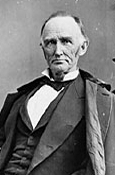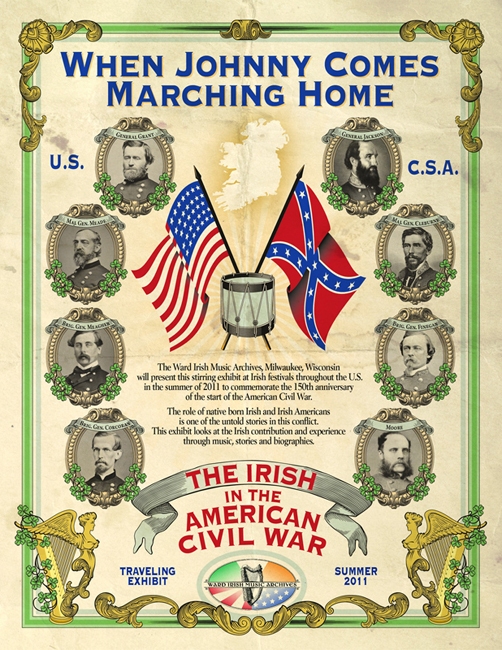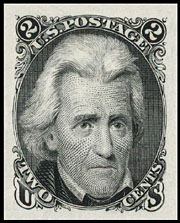
Postage Stamps of the United States - 1863
Politics

President
Abraham Lincoln

Postmaster General:
Montgomery Blair
Music

Click Control Above To Hear
1863 "When Johnny Comes Marching Home"
Postage Rates
Prior to 1863 letters were dropped off at post offices or street mail boxes. The addressee was required to pick up the letter from the post office to which it was ultimately delivered. In some of the larger cities, for a small fee of usually one or two cents, the letter could be delivered (carried) to the street address of the addressee. In 1863, for the first time, free delivery to the street address was made available in 49 of the largest cities in the U.S. Over time many more cities instituted this free delivery, something which we take for granted today. However, it wasn't until 1896 that the first free rural deliveries were instituted on a trial basis in West Virginia. Over time, RFD, or rural free delivery, became an important part of the U.S. Postal Service and is taken for granted today, as well.
The following rates applied from Mar. 31, 1855 to June 30, 1863
Domestic Letter Rate East of the Rockies per ½ oz.: Three Cents
Domestic Letter Rate crossing the Rockies per ½ oz.: Ten Cents
Foreign Letter Rate under 2500 mi. per ½ oz.: Ten Cents - except where otherwise adjusted by treaty
Foreign Letter Rate over 2500 mi. per ½ oz.: 20¢ - except where otherwise adjusted by treaty
Rate for Drop Letters: One Cent
Rate for Newspapers and Circulars up to 3 oz.: One Cent, with one cent for each additional oz.
Carrier Fee (not available in all cities): One Cent - this service was abolished on July 1, 1863
Registry Fee: 5¢ (no return receipt to sender) - Paid in cash
The following rates began on July 1, 1863 (Act of March 3, 1863)
Domestic Letter Rate Regardless of Distance per ½ oz.: Three Cents
Foreign Letter Rate under 2500 mi. per ½ oz.: Ten Cents - except where otherwise adjusted by treaty
Foreign Letter Rate over 2500 mi. per ½ oz.: 20¢ - except where otherwise adjusted by treaty
Rate for Newspapers and Circulars up to 4 oz.: Two Cents
Carrier Fee within Larger Cities: Free - Carriers were no longer paid per letter, postal employees were salaried to act as carriers. Thus was born the U.S. mailman as we know them today - although, according to Webster's, the term mailman first came to use in 1881.
Rate for Drop Letters per ½ oz.: Two Cents. The rate was raised from one cent to two cents and weight was now a factor. The rate was changed back to one cent in May of 1865.
Registry Fee : 20¢ - with return receipt to sender, paid in cash. Although the jump from five cents to twenty cents in the registry fee may seem steep, it was a necessity. Postmasters had complained that the extra time and effort needed to handle the registered letters was not covered by the five cent fee. Postmaster General Blair petitioned Congress to raise this rate to twenty cents, along with many other sweeping changes and Congress complied with most of them. The registry fee was to be paid with money and not with stamps. Thus a registered letter from the early 1860's will not have the added postage for the registry fee in the form of additional stamps on the envelope, making the identification of a registered letter from this period sometimes difficult. The Act of 1863 also stated that the word "REGISTERED" should be clearly stamped on the face of the letter, although this was often not done, again making identification difficult. Not until June of 1867 was the registration fee to be paid in stamps.
Stamps

2¢ Jackson of 1863
The "Black Jack"
Admitted to the Union: West Virginia on June 20, 1863
The following postage stamp varieties were first issued by the U.S. in 1863:
Scott 73 - 2¢ Black Jackson - EDU: July 1, 1863 (off cover); July 6, 1863 (on cover) - about 257 million issued
Scott 76 - 5¢ Brown Jefferson - EDU: Feb. 3, 1863 - about 6.5 million issued
Scott 76a - 5¢ Black Brown Jefferson
Scott 78 - 24¢ Lilac Washington - EDU(?): Feb. 20, 1863 - about 9.6 million issued
Scott 78c - 24¢ Black Violet Washington - EDU: May 1, 1863
Commemoratives: The first Commemorative stamps were not issued until 1893
Special Delivery: The first Special Delivery stamps were not issued until 1885
Postage Dues: The first Postage Due Stamps were not issued until 1879
see also: Designs of All 1861-1868 Regular Issues





